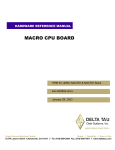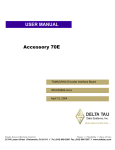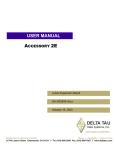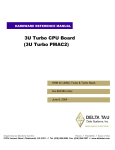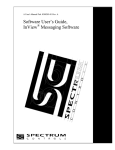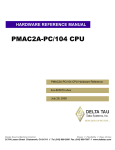Download Delta Tau 16-AXIS Reference Manual
Transcript
^1 HARDWARE REFERENCE MANUAL ^2 16-Axis MACRO CPU Preliminary Documentation ^3 16-Axis MACRO CPU ^4 4Ax-603719-xHxx ^5 April 21, 2010 Single Source Machine Control Power // Flexibility // Ease of Use 21314 Lassen Street Chatsworth, CA 91311 // Tel. (818) 998-2095 Fax. (818) 998-7807 // www.deltatau.com Copyright Information © 2010 Delta Tau Data Systems, Inc. All rights reserved. This document is furnished for the customers of Delta Tau Data Systems, Inc. Other uses are unauthorized without written permission of Delta Tau Data Systems, Inc. Information contained in this manual may be updated from time-to-time due to product improvements, etc., and may not conform in every respect to former issues. To report errors or inconsistencies, call or email: Delta Tau Data Systems, Inc. Technical Support Phone: (818) 717-5656 Fax: (818) 998-7807 Email: [email protected] Website: http://www.deltatau.com Operating Conditions All Delta Tau Data Systems, Inc. motion controller products, accessories, and amplifiers contain static sensitive components that can be damaged by incorrect handling. When installing or handling Delta Tau Data Systems, Inc. products, avoid contact with highly insulated materials. Only qualified personnel should be allowed to handle this equipment. In the case of industrial applications, we expect our products to be protected from hazardous or conductive materials and/or environments that could cause harm to the controller by damaging components or causing electrical shorts. When our products are used in an industrial environment, install them into an industrial electrical cabinet or industrial PC to protect them from excessive or corrosive moisture, abnormal ambient temperatures, and conductive materials. If Delta Tau Data Systems, Inc. products are directly exposed to hazardous or conductive materials and/or environments, we cannot guarantee their operation. REVISION HISTORY REV. DESCRIPTION DATE CHG APPVD 1 ADDED CE DECLARATION OF CONFORMITY 08/23/06 CP S. FIERRO 2 ADDED INDICATOR LEDs, PP.11-12 04/21/10 CP S. MILICI 16-Axis MACRO CPU Hardware Reference Manual Table of Contents INTRODUCTION .....................................................................................................................................................1 3U Product Configurations (General Description)..................................................................................................2 Configuration ..........................................................................................................................................................3 SPECIFICATIONS ...................................................................................................................................................4 Environmental Specifications..................................................................................................................................4 Physical Specifications............................................................................................................................................4 Electrical Specifications ..........................................................................................................................................4 EMC and Safety ......................................................................................................................................................4 HARDWARE SETUP ...............................................................................................................................................5 Board Jumper and Switch Summary .......................................................................................................................5 Board Connections ..................................................................................................................................................6 Connector Summary ...........................................................................................................................................6 Hardware Re-initialization ......................................................................................................................................7 JUMPER AND SWITCH CONFIGURATIONS ...................................................................................................9 Layout .....................................................................................................................................................................9 Jumper Descriptions................................................................................................................................................9 E1: Watchdog Timer Disable ............................................................................................................................9 E2: CPU Mode Operation .................................................................................................................................9 E3: Serial Port Baud Rate .................................................................................................................................9 E4: Power Supply-Loss Control (±15Vdc Supply Monitor) ..............................................................................9 E40: MACRO Input (Fiber/Wired) Selector ......................................................................................................9 Switch Configurations...........................................................................................................................................10 SW1: MACRO Slave Node Configure..............................................................................................................10 SW2: MACRO IC 0 Master Number Select .....................................................................................................10 CHARACTER DISPLAY AND LEDS..................................................................................................................11 CONNECTOR PINOUTS ......................................................................................................................................13 Main Board Connectors (603719).........................................................................................................................13 J14, J17: MACRO Copper I/O (OPT C)...........................................................................................................13 U73: MACRO Fiber Optic Connector (OPT A) ...............................................................................................13 TB1: (JPWR) 4-Pin Terminal Block .................................................................................................................14 TB2: (JWD) 4-Pin Terminal Block ...................................................................................................................14 P1: UBUS Interface Connector ........................................................................................................................15 Daughter Board Connections (603720).................................................................................................................16 J2 (JDISP) Display Connector .........................................................................................................................16 J3 (JHW) Handwheel Encoder Connector .......................................................................................................16 J4: (JRS232) Serial Port Connector ................................................................................................................17 HARDWARE MEMORY MAP.............................................................................................................................19 ACCESSORIES.......................................................................................................................................................21 DECLARATION OF CONFORMITY .................................................................................................................23 Table of Contents i 16-Axis MACRO CPU Hardware Reference Manual ii Table of Contents 16-Axis MACRO CPU Hardware Reference Manual INTRODUCTION The 16-Axis MACRO CPU board is the processor and MACRO interface board used in a 3U MACRO Station (in either UMAC MACRO or MACRO Stack configuration). Note: There are three documents that describe the operation of 3U MACRO Station products: • UMAC System Manual (General Product Overview) • MACRO 16 Station User’s Manual • MACRO 16 Station Software Reference This manual describes the interfaces and physical hardware that is used on the 3U MACRO CPU. The UMAC 16-Axis MACRO CPU provides a remote interface for encoders, flags, direct-PWM digital drives, analog drives, stepper drives, analog I/O, and digital I/O for Delta Tau Data’s PMAC products that have a MACRO interface. The UMAC 16-Axis MACRO CPU configurations communicate with PMAC2 Ultralites or Turbo PMAC2 Ultralites solely through the MACRO ring, interfacing to standard drives, encoders, flags, and I/O through on-board connectors. In almost every case, a Turbo Ultralite or UMAC CPU with Acc-5E will be used as the MACRO Master. This 16-Axis MACRO CPU integrated packaging and connectivity strategy provides revolutionary flexibility and ease of use. A 16-Axis MACRO CPU consists of a set of 3U format Euro-cards (100 x 160 mm) that can be assembled in a variety of configurations. When used in the rack configuration, connected through a backplane bus, the backplane is UBUS format, designed by Delta Tau Data Systems Inc. for motion control and I/O interfaces. When using the fiber optic MACRO interface, the 3U MACRO Station can be up to three kilometers (two miles) away from the PMAC2 Master controller or any other station on the ring. When using the RJ-45 copper electrical interface, it can be up to 30 meters (100 feet) away. The 16-Axis MACRO CPU Station allows PMAC2 MACRO controllers to control servo axes and I/O just as if they were connected directly to the PMAC2, even though they may be a great distance away. The only interface needed from the PMAC2 is the electrically isolated MACRO ring. Typically, a PMAC2 Turbo Ultralite board, one without any of its own servo interface circuitry, is used with the MACRO Station to provide the most cost-effective solution. 16-Axis MACRO CPU 3U Board (3A0-603719-10x): • 100MHz DSP56309 CPU • 512k x 8 flash memory for user backup and firmware • Latest released firmware version • RS-232 serial interface for setup and debugging • UBUS connector for backplane connection to servo and I/O accessory boards • JHW H/W Pulse/Dir port with 20-pin IDC header • JDISP Standard PMAC Display 14-pin header. The 16-Axis MACRO CPU can only be configured as a UMAC MACRO configuration. The older generation MACRO8 CPU can be used as either a UMAC MACRO or a MACRO Stack. Introduction 1 16-Axis MACRO CPU Hardware Reference Manual UMAC MACRO – In this configuration (once called Pack) the 3U-format boards are put together to communicate through a backplane bus called the UBUS. All boards are installed in a Euro-card rack. In this configuration, all 3U-format boards or modules can be installed or withdrawn from the pack individually, providing ease of installation, debugging, and repair. The photo at the upper right shows a UMAC rack with power supply and I/O boards that are connected through a backplane. This system allows for an easier integration of the 3U 16x MACRO CPU for larger (up to 16 axes) applications. UMAC MACRO Station Configuration 3U Product Configurations (General Description) Assemblies of 3U-format boards can be made with either of two CPU processor boards – a 3U MACRO CPU board, or a 3U Turbo PMAC2 CPU board. Most other 3U-format boards, labeled Accessory boards, can be used with either CPU board. • When the 3U 16-Axis MACRO CPU board is used, the resulting assemblies are called UMAC MACRO or 3U MACRO Stack. • When the 3U Turbo PMAC2 CPU board is used, the resulting assemblies are called UMAC Turbo or Turbo Stack. Refer to the UMAC Product Guide for more detailed descriptions of how the rack and stack products are integrated. UMAC and 3U-Stack Products UMAC Products 2 Stack Products UMAC Turbo UMAC MACRO Turbo Stack MACRO Stack The UMAC Turbo is composed of a 3U-format Turbo PMAC2 CPU board and a set of accessory boards in 3U-format, all plugged in a common UBUS backplane and installed inside a 3U format rack. A PC/104 computer and several optional communication accessories (including all of the major FieldBuses, MACRO and Ethernet) can be installed inside the UMAC system providing convenient flexibility and virtually unlimited expandability. The UMAC MACRO is composed of a MACRO Interface/CPU board and a set of accessory boards in 3Uformat, all plugged in a common UBUS backplane and installed inside a 3U format rack. The UMAC MACRO must receive commands from an external MACRO compatible device like a PMAC2 Ultralite or a UMAC Turbo system. The UMAC MACRO does not support a PC/104 or communication accessories and it is preferred for distributed control over a MACRO ring connection. The Turbo stack is composed of a 3U-format Turbo PMAC2 CPU board and a set of accessory boards in 3U-format plugged to it in a stack configuration. The Turbo stack configuration is less expensive than the UMAC Turbo system but it is limited to eight axes of motion control versus 32 axes on a UMAC Turbo system. The Turbo Stack is selected over a UMAC Turbo system because is more compact, allowing its installation inside already existing cabinets with some space limitations. The MACRO stack is composed of a MACRO Interface/CPU board and a set of accessory boards in 3U-format plugged to it in a stack configuration. The UMAC MACRO must receive commands from an external MACRO compatible device like a PMAC2 Ultralite or a UMAC Turbo system. The MACRO Stack is selected over a UMAC MACRO syst em because it is more compact, allowing its installation inside already existing cabinets with some space limitations. Introduction 16-Axis MACRO CPU Hardware Reference Manual Configuration The purchase of the 3U 16-Axis MACRO CPU board provides a 3U-format (100mm x 160mm) board with a DSP processor, MACRO ring circuitry, and a backplane connector through which other 3U-format boards can be connected by means of a UBUS passive-backplane board. The 3U 16-Axis MACRO CPU can be purchased in two physical configurations, distinguished by part number prefix: • 300-603719-10x provides the 16-Axis MACRO CPU board without a front plate. This configuration is recommended for stack assemblies. • 3A0-603719-10x provides the 16-Axis MACRO CPU board with a front plate. This configuration is recommended for UMAC rack assemblies. The top and bottom plates are provided with the Acc-Px rack. There are a few options available for the 16-Axis MACRO CPU board. One of the Options A or C must be present on a 16-Axis MACRO CPU board to provide the actual MACRO ring interface circuitry; both may be present: Option A provides an SC-style fiber-optic transceiver to connect into the MACRO ring. Its main component is the U73 transceiver. Option C provides RJ-45 electrical input and output connectors for the MACRO ring. Its main components are J14 and J17. Option 10 permits a specified revision of the MACRO Station firmware to be installed in the flash memory in the card. Without this option, the latest released revision is installed. A label on the flash memory IC indicates the firmware revision installed at the factory (but not necessarily which revision is presently installed in the IC). The presently installed revision can be ascertained by using the MSVER{node #} command. Introduction 3 16-Axis MACRO CPU Hardware Reference Manual SPECIFICATIONS Environmental Specifications Description Specification Notes Operating Temperature Storage Temperature Humidity 0°C to 45°C, -25°C to 70°C 10% to 95 % non-condensing Physical Specifications Description Specification Dimensions Length: 16.256 cm Notes (6.4 in.) Height: 10 cm (3.94 in.) Width: 2.03 cm (0.8 Weight in.) 188 g Front Plate included The width is the width of the front plate. The length and height are the dimensions of the PCB. Electrical Specifications Description Specification Power Requirements 5V @ 2.5A (±10%) Notes EMC and Safety Item Description CE Mark EMC Full Compliance Safety Flammability Class 4 EN55011 Class A Group 1 EN61000-3-2 Class A EN61000-3-3 EN61000-4-2 EN61000-4-3 EN61000-4-4 EN61000-4-5 EN61000-4-6 EN61000-4-11 EN 61010-1 UL 94V-0 Specifications 16-Axis MACRO CPU Hardware Reference Manual HARDWARE SETUP The hardware setup of the 3U 16-Axis MACRO CPU Board consists of the setting of two rotary switches, the setting of several E-point jumpers on each board, followed by power supply and signal connections. Note: E-Point Jumper numbers are shown in white ink on the legend of each board. Pin numbers for each jumper can be determined either from the legend on the component side on the board or by looking at the solder side of the board, where pin 1 has a square solder pad. Board Jumper and Switch Summary The MACRO Station has two 16-way rotary switches on the 16-Axis MACRO CPU board that establish the station’s basic configuration on the MACRO ring. SW1 Rotary Switch Setting: SW1 establishes how many servo nodes and which servo nodes, will be used on the MACRO station MACRO IC 0. It also establishes the mapping of MACRO node numbers to MACRO Station channel numbers. This mapping information will be important in establishing the software setup. More detailed information on the SW1 settings is presented in the Jumper/Switch description in the back of this manual. SW2 Rotary Switch Setting: SW2 establishes the number of the master IC to which the MACRO station will respond. The values of 0 to 15 correspond to Master numbers 0 to 15, respectively. For a non-Turbo PMAC2 master, this value must match the master number value in the first hexadecimal digit of PMAC2’s I996. For a Turbo PMAC2, this value must match the master number value in the first hexadecimal digit of the Turbo PMAC2’s I6840, I6890, I6940, or I6990, for MACRO ICs 0, 1, 2, or 3, respectively, on the Turbo PMAC2. The default switch setting is 0, so the station will respond to Master 0. Watchdog Timer Enable Jumper: For normal operation of the Compact MACRO Station, jumper E1 should be OFF to enable the watchdog timer (an important safety feature). Operational Mode Jumper: Jumper E2 should connect pins 2 and 3 to tell the CPU it is in normal operational mode, not in bootstrap mode. To load new firmware into the flash IC through the serial port, it should only connect pins 1 and 2. Baud Rate Jumper: Jumper E3 must be ON if connecting an Acc-8D Option 9 Yaskawa absolute encoder converter to the J7 serial port (most will connect it to the JTHW port instead). This sets the baud rate to 9600. If E3 is OFF, the baud rate is 38400. Power Supply Check Jumper: Remove jumper E4 if not bringing a +/-12V to +/-15V supply into the Compact MACRO Station itself (5V only). If bringing these analog circuit supplies into the Compact MACRO Station, have jumper E4 on so that the servo outputs are disabled if either of the analog supplies is lost. MACRO Input Select Jumper: Because the 16-Axis MACRO CPU board can accept MACRO ring input from either the RJ-45 electrical input or the fiber input, select which input is used (even if only one of the ring interface options is present). Jumper E40 must be ON to use the fiber input; it must be OFF to use the electrical input. (If both interface options A and C are present, either ring output may be used, regardless of the setting of E40.) Hardware Setup 5 16-Axis MACRO CPU Hardware Reference Manual Board Connections The connection of Compact MACRO Station to other stations on the MACRO ring is achieved by connecting the output connector of the Compact MACRO Station to the input connector of the next station, and by connecting the output connector of the previous station to the input connector of the Compact MACRO Station. There must be a completely connected ring with all stations powered up, for any communications to occur on the ring. Connector Summary The connectors on the 16-Axis MACRO CPU are found on both the main (603719-10x) board and on an I/O daughter card (603720-10x) that plugs into the main board. Main Board Connections (603719) JISP: For Factory use only J4: * RJ45: MACRO Copper I/O (OPT C) J14, J17: JEXP: Backplane Expansion Port Connector P1: JPWR: 4-Pin Terminal Block TB1: JWD: Watchdog Relay Terminal block TB2: MACRO Fiber Optic Connector (OPT A) U73: * Typically, these connectors are not designated as end-user interfaces. The pinouts are not included in this hardware reference manual. Consult the factory if pinout information is needed. I/O Daughter Board Connections (603720) JDISP: 40x2 Segment Display Connector J2: * JHW: Two channel handwheel encoder /Two Channel Pulse/Direction Outputs J3:* JRS232: RS232 Serial Communication port J4: * * Typically, these connectors are not designated as end-user interfaces. The pinouts are not included in this hardware reference manual. Consult the factory if pinout information is needed. Optical Fiber Ring Connection: The U73 integrated fiber optic transceiver is used for both the optical fiber input and the optical fiber output connections to the MACRO ring. With the component side of the board up and the opening facing front, the input socket is on the right, and the output socket is on the left (these are marked on the component). RJ45 Electrical Ring Connection: The J14 connector is used for the input from the previous station on the MACRO ring if electrical connection is used and the J17 connector is used for the output to the next station on the MACRO ring. Backplane UBUS Expansion Port: The P2 96-pin DIN header is used to connect to expansion port accessories such as the Acc-9E, 10E, 11E, 12E, and 14E I/O boards, or the Acc-24E2x axis boards, through an Acc-Ux UBUS backplane board. It can be used also to bring in 5V power, and optionally +/15V power, from a backplane or breakout board to the entire MACRO Station. Power Terminal Block: The TB1 4-point terminal block can be used to bring in 5V power and optionally +/-15V power to the entire MACRO Station. In a UMAC (pack) configuration, usually the power is brought in through the backplane. Watchdog Terminal Block: The TB2 4-point terminal block can be used to send normally opened or open normally closed circuits in the event of a watchdog failure at the 16-Axis MACRO CPU. 6 Hardware Setup 16-Axis MACRO CPU Hardware Reference Manual Hardware Re-initialization MACRO hardware re-initialization to factory defaults is enabled when the SW1 setting is set to 15 or F (hexadecimal) and the power is cycled at the MACRO Station. The only time to use a hardware reinitialization to factory defaults with the MACRO Station would be if the MACRO Station always powers up with a watchdog (typically if the ring clock at the Ultralite is different from the ring clock at the MACRO Station). Node 11 will be the only MACRO Station node enabled. Therefore, enable node 11 of the MACRO IC at the Ultralite to communicate to the MACRO Station. Ultralite Example: Servo nodes 0,1,4,5 enabled at Ultralite (I996=$0F8033) 1. Enable node 11, I996=$0F8833. 2. Then reestablish communications with MS11,(MIvar) commands. 3. Issue MS$$$***11 command to ensure re-initialization. 4. Issue MSSAVE11 command to save the factory defaults to the Station. Turbo Ultralite Example: Servo nodes 0,1,4,5 enabled at Ultralite (I6841=$0F8033) 1. Enable node 11, I996=$0F8833. 2. Then reestablish communications with MS11,(MIvar) commands. 3. Issue MS$$$***11 command to ensure re-initialization. 4. Issue MSSAVE11 command to save the factory defaults to the Station. Hardware Setup 7 16-Axis MACRO CPU Hardware Reference Manual 8 Hardware Setup 16-Axis MACRO CPU Hardware Reference Manual JUMPER AND SWITCH CONFIGURATIONS Layout Jumper Descriptions E1: Watchdog Timer Disable Jumper Type 2-Pin Description Default Remove jumper to enable Watchdog Timer. Jump pins 1 and 2 to disable Watchdog Timer (for test purposes only). not jumpered E2: CPU Mode Operation Jumper Type 3-Pin Description Default Jump pins 1 and 2 for firmware download through serial port. Jump pins 2 and 3 for normal operation. Pin 2-3 E3: Serial Port Baud Rate Jumper Type 2-Pin Description Default Jump pins 1 and 2 for 9600-baud serial port operation. Remove jumper for 38400 Baud. not jumpered E4: Power Supply-Loss Control (±15Vdc Supply Monitor) Jumper Type 2-Pin Description Default Jump pins 1 and 2 to disable servo outputs on loss of +5V, +15V, or –15V power supply. not jumpered Remove this jumper to monitor +5Vdc power supply only. Usually, ±15V supply monitoring is not required for applications without DACs or A-D converters. E40: MACRO Input (Fiber/Wired) Selector Jumper Type Description Default 2-Pin Remove jumper to select MACRO wired (RJ45) input from J14. Jump pins 1 and 2 to select MACRO fiber optic input from U73. Jumpered (Option A) Not jumpered (Option C) Jumper and Switch Configurations 9 16-Axis MACRO CPU Hardware Reference Manual Switch Configurations SW1: MACRO Slave Node Configure SW1 Select I/O Nodes Enabled Servo Nodes Enabled Node Servo IC Base Address Nodes Enabled Y:I181…188 0 0 4 1 0 4 2 3 4 5 6 0 0 0 0 0 2 2 2 2 6 7 0 8 $8000,$8008, $8010,$8018 $8000,$8008, $8010,$8018 $8000,$8008 $8000,$8008 $8000,$8008 $8000,$8008 $8000,$8008, $8010,$8018, $8040,$8048 $8000,$8008, $8010,$8018, $8040,$8058, $8050,$8058 I181, I182, I183, I184 I185, I186, I187, I188 I181, I182 I183, I184 I185, I186 I187, I188 I181, I182, I183, I184, I185, I186 I181, I182, I183, I184, I185, I186, I187, I188 8 9 10 11 12 13 14 (Ring Order) 2 2 2 4 6 1 0 0 0 0 0 0 0 0 0,1, 4,5 8,9, 12,13 0,1 4,5 8,9 12,13 0,1, 4,5, 8,9 0,1, 4,5, 8,9, 12,13 2,3 6,7 10,11 2,3,6,7 2,3,6,7,10,11 11 None 15 (Equivalent to a $$$***) 1 0 $8000,$8008, $8010,$8018, $8040,$8058, $8050,$8058 (if two Servo ICs) I181, I182, I183, I184, I185, I186, I187, I188 11 SW2: MACRO IC 0 Master Number Select 0: Commanded from Master IC # 0 1: Commanded from Master IC # 1 … F: Commanded from Master IC # F (15) 10 Jumper and Switch Configurations 16-Axis MACRO CPU Hardware Reference Manual CHARACTER DISPLAY AND LEDS The MACRO Station has a single hexadecimal character display on the CPU/Interface Board that provides useful information as to the status of the station. The display indicates how many motors are activated and displays certain types of failures that might occur. One unique feature on the display is the LED dot in the bottom left corner. When this LED is illuminated, that means 8 must be added to the number being displayed. For example, if the display reads 4 and the LED dot is illuminated, that would mean that there are 12 axes enabled at the 16-Axis MACRO CPU. The display can show the following values: Value Meaning (Blank) 0-8 9 A B C D E F Dot Ring not active Operation OK; value is # of motors enabled (Reserved for future use) Amplifier fault Ring break fault CPU failure fault Ring data error Loss-of-encoder fault Other failure Add 8 to the number of enabled Axes # Activated Axes # Activated Axes +8 Note: The display can be read at the Ultralite with MI974. This is useful especially for user interface programs and for systems that are in inconvenient locations to read the display. Character Display AND ledS 11 16-Axis MACRO CPU Hardware Reference Manual There are also three LEDs on the front panel (left adjacent to the seven-segment LED display) indicating the following: D7 (PW) – Green Power LED indicating the +5V is on and OK. D8 (WD) – Red WATCHDOG LED indicating a watchdog condition. D12 (LINK) – Dual Color MACRO Link Activity Indicator Green = Link OK Red = Link FAULT 12 Character Display AND ledS 16-Axis MACRO CPU Hardware Reference Manual CONNECTOR PINOUTS The schematic circuits shown in this section are for interface reference only. Subtle differences may exist between the circuits shown here and the actual hardware used. The connectors on the 16-Axis MACRO CPU are found on both the main (603719-10x) board and on an I/O daughter card (603720-10x) that plugs into the main board. Main Board Connectors (603719) J14, J17: MACRO Copper I/O (OPT C) (8 pin RJ45) Front View Pin # Symbol Function 1 DATA+ Data + Description Notes Differential MACRO Signal J17: DATA+ input J14: DATA+ output 2 DATAData Differential MACRO Signal J17: DATA- input J14: DATA- output 3 Unused Unused terminated pin See schematic below 4 Unused Unused terminated pin See schematic below 5 Unused Unused terminated pin See schematic below 6 Unused Unused terminated pin See schematic below 7 Unused Unused terminated pin See schematic below 8 Unused Unused terminated pin See schematic below The cable used for MACRO wired connections is CAT5 verified straight-through 8 conductor. J14 J14 1 2 3 4 5 6 7 8 CON8 50 50 50 50 50 50 50 J17 50 50 WIRED OUTPUT rj45 tx+ tx- U94 14 15 16 3 2 1 CT TDTD+ CMT TXTX+ CT RDRD+ CT RXRX+ 12 11 10 J17 1 2 3 4 5 6 7 8 WIRED INPUT rj45 rx+ rx- CON8 5 6 7 50 50 50 50 50 50 PE-68515 M3 MTG HOLE 75 75 50 50 50 .01 mfd 2kv Circuitry for J14 and J17- Copper MACRO I/O U73: MACRO Fiber Optic Connector (OPT A) (2 Socket SC-Style) Pin # Symbol Front View Function Description Notes 1 RX Fiber Input MACRO Ring Receiver 2 TX Fiber Output MACRO Ring Transmitter 1. The fiber optic version of MACRO uses 62.5/125 multi-mode glass fiber optic cable terminated in an SC-style connector. The optical wavelength is 1,300nm. 2. It is possible to adapt wire to fiber operation when using OPT A and C on the same MACRO CPU board. Connector Pinouts 13 16-Axis MACRO CPU Hardware Reference Manual TB1: (JPWR) 4-Pin Terminal Block (Location B-4) Pin # Symbol Function 1 2 3 4 GND +5V +15V -15V Common Input Input Input Description Reference Voltage Positive Supply Voltage Positive Supply Voltage Negative Supply Voltage Notes Supplies all PMAC digital circuits +12V to +15V; used for on-board analog -12 to –15V; used for on-board analog TB2: (JWD) 4-Pin Terminal Block Pin # Symbol Function 1 2 3 4 NC COM NO COM Output Input Output Input 14 Description Notes Normally Closed Common Input Normally Open Common Input Connector Pinouts 16-Axis MACRO CPU Hardware Reference Manual P1: UBUS Interface Connector (96 pin Euro Connector at F-1, 2, 3, 4) Front View on MACRO CPU Card Pin # 1. 2. Row A Row B Row C 1 +5Vdc +5Vdc +5Vdc 2 GND GND GND 3 BD01 DAT0 BD00 4 BD03 SEL0 BD02 5 BD05 DAT1 BD04 6 BD07 SEL1 BD06 7 BD09 DAT2 BD08 8 BD11 SEL2 BD10 9 BD13 DAT3 BD12 10 BD15 SEL3 BD14 11 BD17 DAT4 BD16 12 BD19 SEL4 BD18 13 BD21 DAT5 BD20 14 BD23 SEL5 BD22 15 BS1 (GND) DAT6 BS0 (GND) 16 BA01 SEL6 BA00 17 BA03 DAT7 BA02 18 BX/Y SEL7 BA04 (n.c.) 19 CS3BA06 (n.c.) CS220 BA05 (CS7-) BA07 (n.c.) CS4- (CS6-) 21 CS12BA08 (n.c.) CS1022 CS16BA09 (n.c.) CS1423 BA13 (n.c.) BA10 (n.c.) BA12 (n.c.) 24 BRDBA11 (n.c.) BWR25 BS3 (GND) MEMCS0- (n.c.) BS2 (GND) 26 n.c. MEMCS1- (n.c.) RESET 27 PHASE+ n.c. SERVO+ 28 PHASE- (n.c.) n.c. SERVO- (n.c.) 29 GND n.c. GND 30 -15Vdc PWRGUD (n.c.) +15Vdc 31 GND GND GND 32 +5Vdc +5Vdc +5Vdc Refer to the UBUS Specification for detailed signal descriptions. This interface is not VME bus compatible. Items shown in parentheses represent pin descriptions for -104 and earlier revision MACRO CPU boards. Connector Pinouts 15 16-Axis MACRO CPU Hardware Reference Manual Daughter Board Connections (603720) J2 (JDISP) Display Connector Pin # Symbol Function Description Notes 1 +5V Output Logic Power Power supply out 2 GND Common Logic Ground 3 RS Output Read strobe TTL signal out 4 Vee Output Contrast adjust VEE 0 to +5Vdc * 5 E Output Display enable High is enable 6 R/W Output Read or write TTL signal out 7 DB1 Output Display data1 8 DB0 Output Display data0 9 DB3 Output Display data3 10 DB2 Output Display data2 11 DB5 Output Display data5 12 DB4 Output Display data4 13 DB7 Output Display data7 14 DB6 Output Display data6 The JDISP connector is used to drive the 2-line x 24-character (Acc-12), 2 x 40 (Acc-12A) LCD, or the 2 x 40 vacuum fluorescent (ACC 12C) display unit. The DISPLAY command may be used to send messages and values to the display. J3 (JHW) Handwheel Encoder Connector Pin # Symbol Function Description Notes 1 GND Common Reference voltage 2 +5V Output Supply voltage To power external circuitry 3 HWA1+ Input HW positive A channel Also pulse input 4 HWA1Input HW negative A channel Also pulse input 5 HWB1+ Input HW positive B channel Also direction input 6 HWB1Input HW negative B channel Also direction input 7 HWA2+ Input HW positive A channel Also pulse input 8 HWA2Input HW negative A channel Also pulse input 9 HWB2+ Input HW positive B channel Also direction input 10 HWB2Input HW negative B channel Also direction input 11 PUL1+ Output PFM positive pulse Also PWM bottom output 12 PUL1Output PFM negative pulse Also PWM bottom output 13 DIR1+ Output PFM positive dir out Also PWM top output 14 DIR1Output PFM negative dir out Also PWM top output 15 PUL2+ Output PFM positive pulse Also PWM bottom output 16 PUL2Output PFM negative pulse Also PWM bottom output 17 DIR2+ Output PFM positive dir. out Also PWM top output 18 DIR2Output PFM negative dir out Also PWM top output 19 GND Common Reference voltage 20 +5V Output Supply voltage To power external circuitry The VHW connector provides for two 2-channel encoder inputs and two sets of pulse outputs. 16 Connector Pinouts 16-Axis MACRO CPU Hardware Reference Manual J4: (JRS232) Serial Port Connector DB9-pin Female Pin # Symbol Function 1 2 3 4 5 6 7 8 9 N.C. TXD/ RXD/ DSR GND DTR CTS RTS N.C. Output Input Bidirect Common Bidirect Input Output Connector Pinouts 5 4 9 3 8 2 7 Description No connection Send Data Receive Data Data Set Ready MACRO Common Data Terminal Ready Clear to Send Request to Send No connection 1 6 Notes Transmit data to host Receive data from host Just tied to DTR Just tied to DSR Host Ready bit PMAC Ready bit 17 16-Axis MACRO CPU Hardware Reference Manual 18 Connector Pinouts 16-Axis MACRO CPU Hardware Reference Manual HARDWARE MEMORY MAP The values in this table represent the hardware locations associated with register-based transactions that occur in the 16-Axis MACRO CPU. Reference ADDR (hex) CS00CS02CS04CS06CS0CS1CS2CS3CS4CS4XCS10- $FFC0 $FFC8 $FFD0 $FFD8 $C000 $C020 $8000 $8040 $C080 $C0C0 $8800,$9800 $A800,$B800 $8840,$9840 $A840,$B840 $8880,$9880 $A880,$B880 $88C0,$98C0 $A8C0,$B8C0 $D000 $E000 CS12CS14CS16MEMCS0MEMCS1- Description Stack I/O select #1 (not used with MACRO 16-Axis CPU) Stack I/O select #2 (not used with MACRO 16-Axis CPU) Stack I/O select #3 (not used with MACRO 16-Axis CPU) Stack I/O select #4 (not used with MACRO 16-Axis CPU) Stack axis 1-4 select (not used with MACRO 16-Axis CPU) Stack axis 5-8 select (not used with MACRO 16-Axis CPU) UBUS backplane axis 1-8 select UBUS backplane axis 5-8 select On-board DSPGATE2 select UBUS backplane MACROGATE or DSPGATE2 select (CS4- on UBUS) UBUS backplane I/O select #1 UBUS backplane I/O select #2 UBUS backplane I/O select #3 UBUS backplane I/O select #4 UBUS hardware I/O field (was DPRCS-) UBUS hardware I/O field (was VMECS-) The addressing field size is 16-bits in the 3U 16-Axis MACRO CPU. The address table above is similar to the PMAC2 product line. Hardware Memory Map 19 16-Axis MACRO CPU Hardware Reference Manual 20 Hardware Memory Map 16-Axis MACRO CPU Hardware Reference Manual ACCESSORIES Both the Turbo and the 16-Axis MACRO CPU boards can support either the Stack or the UMAC configuration. The systems are configured modularly with the selection of a series of accessory boards, some appropriate for the Stack and some appropriate for the UMAC. These accessories are listed here. Each has its own manual with detailed descriptions. The following table shows 3U products by function: 16-Axis MACRO CPU Board Options Board must be ordered with either Option A or Option C Option A, fiber-optic connectors Option C, RJ-45 electrical MACRO connectors UMAC BackplaneMountable Accessory Boards – Axis Acc-24E2, 2-Axis Digital PWM, 3x0-603397-10x Option 1A, Additional 2Axis Analog, 3A1-603398-10x Acc-65E, Acc-66E, Acc-67E Acc-11E, Isolated 24-In/24Out Board, 3x0-603307-10x Option 1D, Additional 2Axis Digital PWM, 3D1-603397-10x Acc-24E2S, 4-Axis Stepper, 3x0-603441-10x Acc-9E, 48 In, 3x0-603283-10x Acc-12E, Isolated 24-In/24High-Power Out Board, 3x0-603277-10x Acc-24E2A, 2-Axis Analog, 3x0-603398-10x Acc-28E, 16-Bit A/D, 3x0-603404-10x Acc-36E, A/D, D/A Converter, 3x0-603483-10x Acc-53E, SSI, 3x0-603360-10x Acc-58E, R/D Converter, 16 Bit, 3x0-603482-10x Acc-U4, UBUS 4-Slot Backplane, 300-603462 Acc-U10, UBUS 10-Slot Backplane, 300-603464-10x Acc-U16, UBUS 16-Slot Backplane, 300-603471-10x Acc-56E, Extender Card, 300-603401-10x Acc-51E, X 4096 Interpolator, 3x0-603438-10x UMAC BackplaneMountable Accessory Boards – I/O UMAC BackplaneMountable Accessory Boards – Communication UMAC BackplaneMountable Accessory Boards – Miscellaneous UBUS Backplane Boards Amplifiers – Analog ±10VDC Input (Brush Motors) Amplifiers – Digital PWM Input (brushless) Accessories Acc-10E, Isolated 48Output Board, 3x0-603299-10x Acc-14E, 48 I/O, 3x0-603472-10x Acc-72E, (UNET) Universal Field Bus Adapter Network Card 4-Axis Analog ± 10V Input Linear Amplifier, 24VDC, 0.5/1A, 300-603489-10x Backplane, Double Analog Amplifier, 300-603470-10x 2-Axis Digital PWM Amplifier, 360VDC, 4/8A, 400-603391-10x Single-Axis Digital PWM Amplifier, 360VDC, 8/16A, 401-603492-10x Acc-U6, UBUS 6-Slot Backplane, 300-603403-10x Acc-U12, UBUS 12-Slot Backplane, 300-603465-10x Acc-U18, UBUS 18-Slot Backplane, 300-603491-10x 4-Axis Analog ± 10V Input PWM Amplifier, 48VDC, 2/4A, 300-603443-10x Backplane, Single Analog Amplifier, 300-603490-10x 2-Axis Digital PWM/Macro Amplifier, 360VDC, 8/16A, 400-603392-10x Power Supply for 3U Digital PWM Amplifiers, 400-603428-10x Acc-57E, Yaskawa or Mitsubishi ABS, Encoder Unit, 3x0-603484-10x Acc-U8, UBUS 8-Slot Backplane, 300-603463-10x Acc-U14, UBUS 14-Slot Backplane, 300-603466-10x 4-Axis Analog ± 10V Input PWM Amplifier, 70VDC, 8/12A, 300-603486-10x Single Axis Digital PWM/Macro Amplifier, 360VDC, 8/16A, 401-603391-10x Backplane, Digital PWM, 300-603435-10x 21 16-Axis MACRO CPU Hardware Reference Manual 16-Axis MACRO CPU Board Options Board must be ordered with either Option A or Option C. Power Supplies – DC Input Acc-F, 3U DC to DC Converter, 10A, 30F-603216-OPT Acc-E, 3U AC Power Supply, 8A, 30E-603269-OPT 3U Rack, 10-1/2 Slot (42T) 542-602932-10x 3U Rack, Variable Width per Customer Requirements (custom design), 500-602932-10x Power Supplies – AC Input UMAC Chassis Assemblies (Rack) 22 Option A, fiber-optic connectors Option C, RJ-45 electrical MACRO connectors Acc-E1, 3U AC Power Supply, 14A, 31E-603269-OPT 3U Rack, 15-3/4 Slot (63T) 563-602932-10x Acc-E2, AC Power Supply, 20A, 32E-603468-OPT 3U Rack, 21 Slot (84T) 584-602932-10x Accessories 16-Axis MACRO CPU Hardware Reference Manual DECLARATION OF CONFORMITY Application of Council Directive: 89/336/EEC, 72/23/EEC Manufacturers Name: Manufacturers Address: Delta Tau Data Systems, Inc. 21314 Lassen Street Chatsworth, CA 91311 USA We, Delta Tau Data Systems, Inc. hereby declare that the product Product Name: MACRO16 CPU Model Number: 603719 And all of its options conforms to the following standards: EN61326: 1997 EN55011: 1998 EN61010-1 EN61000-3-2 :1995 A14:1998 EN61000-3-3: 1995 EN61000-4-2:1995 A1: 1998 EN61000-4-3: 1995 A1: 1998 EN61000-4-4: 1995 EN61000-4-5: 1995 EN61000-4-6: 1996 EN61000-4-11: 1994 Date Issued: Place Issued: Electrical equipment for measurement, control, and laboratory useEMC requirements Limits and methods of measurements of radio disturbance characteristics of information technology equipment Electrical equipment for measurement, control, and laboratory use- Safety requirements Limits for harmonic current emissions. Criteria A Limitation of voltage fluctuations and flicker in low-voltage supply systems for equipment with rated current ≤ 16A. Criteria B. Electro Static Discharge immunity test. Criteria B Radiated, radio-frequency, electromagnetic field immunity test. Criteria A Electrical fast transients/burst immunity test. Criteria B Surge Test. Criteria B Conducted immunity test. Criteria A Voltage dips test. Criteria B and C 11 May 2006 Chatsworth, California USA Yolande Cano Quality Assurance Manager Mark of Compliance Declaration of Conformity 23






























